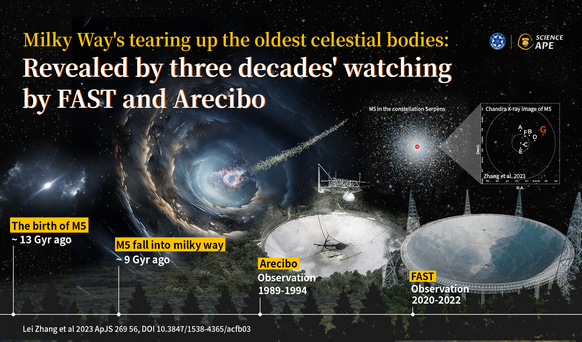Milky Way's tearing up the oldest celestial bodies: revealed by three decades' watching by FAST and Arecibo

Image: Discovery and Timing of Millisecond Pulsars in the Globular Cluster M5 with FAST and Arecibo. (Credit: NAOC/Science APE)
Globular clusters (GCs) are dense stellar clusters with an average evolution age exceeding ten billion years, making them one of the oldest celestial bodies in the Universe. Millisecond pulsars (MSPs) in GCsare important diagnostic tools for a suite of astrophysical problems.
Five-hundred-meter Aperture Spherical radio Telescope (FAST) is the world's largest single-dish radio telescope, the unprecedented sensitivity and innovative design of which has been facilitating cutting-edge research of radio pulsars in GCs.
M5 (NGC 5904) is one of the oldest known globular clusters, with an estimated age of around 13 billion years,seen in the constellation Serpens, approximately 24,500 light-years away from the Earth. It is one of the brighter globular clusters visible in the northern hemisphere.
By using FAST, Dr. Zhang Lei, a China-Australia Astronomy Center (ACAMAR) Postdoctoral fellow, discovered J1518+0205G (M5G),a new millisecond pulsar (MSP) in ablack widow binary in M5, making it the 7th known M5 pulsars, 6 of which are in binaries.
Utilizing the FAST 19-beam receiver, Prof. Li Di, Chief Scientist of FAST at the National Astronomical Observatories of the Chinese Academy of Sciences (NAOC), organized follow-up timing observations for all pulsars in M5. Combining FAST observations with extant Arecibo radio telescope data covering a maximum baseline length of 34 years, the team achieved, for the first time, phase-connected timing solutions for all known pulsars in M5.
The precise positional information obtained from radio timing studies enabled an international collaboration to conduct multi-wavelength research, including optical and X-ray studies using the Hubble and Chandra X-ray space telescopes. Corresponding counterparts were found for pulsars M5C, D, E, F in the optical band and M5C, D, E, G in the X-ray band.
The collaborative efforts unearthed new information from archival data dormant for over three decades and spanning 16 orders of magnitude in electromagnetic wavelength, providing the most comprehensive understanding to date of pulsars in M5 globular cluster.
The study reveals the evolutionary history of the GC and its interaction with the Milky Way, indicating significant mass loss due to tidal interactions with the Milky Way, which manifest itself in the relatively low mass, non-core-collapsed state, and at least one stellar tidal stream of the M5 GC. This study demonstrates that the host galaxy can tear up at least some of the oldest celestial body within.
The relevant work was published online on December 4, 2023, in The Astrophysical Journal Supplement Series (ApJS).
The paper is available at https://iopscience.iop.org/article/10.3847/1538-4365/acfb03
Media Contact:
Prof. XU Ang
Email: annxu@nao.cas.cn
Web: http://english.nao.cas.cn